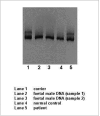The Italian haemophilia B mutation database: a tool for genetic counselling, carrier detection and prenatal diagnosis
- PMID: 19204769
- PMCID: PMC2535890
- DOI: 10.2450/2007.0024-07
The Italian haemophilia B mutation database: a tool for genetic counselling, carrier detection and prenatal diagnosis
Abstract
Introduction: The Italian database of factor IX gene (F9) mutations has been built since 2001 and is, so far, the most practical instrument for comprehensive genetic counselling, carrier detection and prenatal diagnosis. Over time the haemophilia B database has been enriched by entries on a larger number of patients and molecular genetic data identifying heterogeneous mutations spanning the entire F9.
Methods: Conformation sensitive gel electrophoresis is a variant of heteroduplex analysis, which has been applied for screening F9 for mutations, which are further fully characterised by direct sequencing of the amplified mutated regions. This project has involved 29 Italian haemophilia centres and provides data concerning the analysis of a cohort of 306 unrelated patients with haemophilia B (191 with severe, 67 with moderate and 48 with mild disease, including 8 patients with severe haemophilia B with inhibitors). The recorded data include levels of factor IX clotting activity, inhibitor status and clinical severity.
Results: Detailed analysis of the mutations revealed 164 different mutations, that are considered as unique molecular events (8 large deletions, 11 small deletions, 1 combined deletion/ insertion, 2 insertions, 104 missense, 20 nonsense, 14 mutations in a splicing site, 3 in the promoter and 1 silent). The data recorded in the Italian F9 mutation database provided the basis to study 85 families with haemophilia B, involving 180 females (20 obligate carriers, 106 carriers and 54 non-carriers) and enabled 14 prenatal diagnoses to be made in 12 females.
Conclusions: Genetic analysis is required to determine female carrier status reliably. Female relatives may request carrier analysis, when a male relative is first diagnosed as having haemophilia or when they are pregnant. At present, the data collected in the Italian national register of mutations in haemophilia B provide the opportunity to perform prompt and precise determination of carrier status and prenatal diagnosis by specific mutation analysis.
Keywords: F9 mutations; haemophilia B; prenatal diagnosis.
Figures
Similar articles
-
Assessment of the F9 genotype-specific FIX inhibitor risks and characterisation of 10 novel severe F9 defects in the first molecular series of Argentinian patients with haemophilia B.Thromb Haemost. 2013 Jan;109(1):24-33. doi: 10.1160/TH12-05-0302. Epub 2012 Oct 23. Thromb Haemost. 2013. PMID: 23093250 Free PMC article.
-
Mutation analysis of Swedish haemophilia B families - high frequency of unique mutations.Haemophilia. 2016 May;22(3):440-5. doi: 10.1111/hae.12854. Epub 2015 Nov 27. Haemophilia. 2016. PMID: 26612714
-
Molecular genotyping of the Italian cohort of patients with hemophilia B.Haematologica. 2005 May;90(5):635-42. Haematologica. 2005. PMID: 15921378
-
The Canadian "National Program for hemophilia mutation testing" database: a ten-year review.Am J Hematol. 2013 Dec;88(12):1030-4. doi: 10.1002/ajh.23557. Epub 2013 Sep 9. Am J Hematol. 2013. PMID: 23913812 Review.
-
Genetics and molecular biology of haemophilias A and B.Blood Coagul Fibrinolysis. 1991 Aug;2(4):539-65. doi: 10.1097/00001721-199108000-00007. Blood Coagul Fibrinolysis. 1991. PMID: 1768766 Review.
Cited by
-
Enhanced carrier and prenatal diagnosis in the Italian haemophilia B population.Blood Transfus. 2007 Jul;5(3):117-9. doi: 10.2450/2007.0034-07. Blood Transfus. 2007. PMID: 19204763 Free PMC article. No abstract available.
-
Assessment of the F9 genotype-specific FIX inhibitor risks and characterisation of 10 novel severe F9 defects in the first molecular series of Argentinian patients with haemophilia B.Thromb Haemost. 2013 Jan;109(1):24-33. doi: 10.1160/TH12-05-0302. Epub 2012 Oct 23. Thromb Haemost. 2013. PMID: 23093250 Free PMC article.
-
The higher prevalence of missense mutations in hemophilia B compared to hemophilia A could be important in determining a milder clinical phenotype in patients with severe hemophilia B.Haematologica. 2016 Oct;101(10):e429. doi: 10.3324/haematol.2016.150839. Haematologica. 2016. PMID: 27694504 Free PMC article. No abstract available.
-
F8/F9 variants in the population-based PedNet Registry cohort compared with locus-specific genetic databases of the European Association for Haemophilia and Allied Disorders and the Centers for Disease Control and Prevention Hemophilia A or Hemophilia B Mutation Project.Res Pract Thromb Haemost. 2023 Jan 10;7(1):100036. doi: 10.1016/j.rpth.2023.100036. eCollection 2023 Jan. Res Pract Thromb Haemost. 2023. PMID: 36798899 Free PMC article.
-
Investigation of the Bleeding Tendency in Sudanese Female Carriers of Hemophilia B.Biomed Res Int. 2022 Jun 22;2022:6756130. doi: 10.1155/2022/6756130. eCollection 2022. Biomed Res Int. 2022. PMID: 35782080 Free PMC article.
References
-
- Choo KH, Gould KG, Rees DJ, et al. Molecular cloning of the gene for human anti-haemophilic factor IX. Nature. 1982;299:178–80. - PubMed
-
- Yoshitake S, Schach BG, Foster DC, et al. Nucleotide sequence of the gene for human factor IX (antihemophilic factor B) Biochemistry. 1985;24:3736–50. - PubMed
-
- Roberts HR. Molecular biology of haemophilia B. Thromb Haemost. 1993;70:1–9. - PubMed
-
- Belvini D, Salviato R, Radossi P, et al. Molecular genotyping of the Italian cohort of patients with hemophilia B. Haematologica. 2005;90:635–42. - PubMed
LinkOut - more resources
Full Text Sources
Miscellaneous

